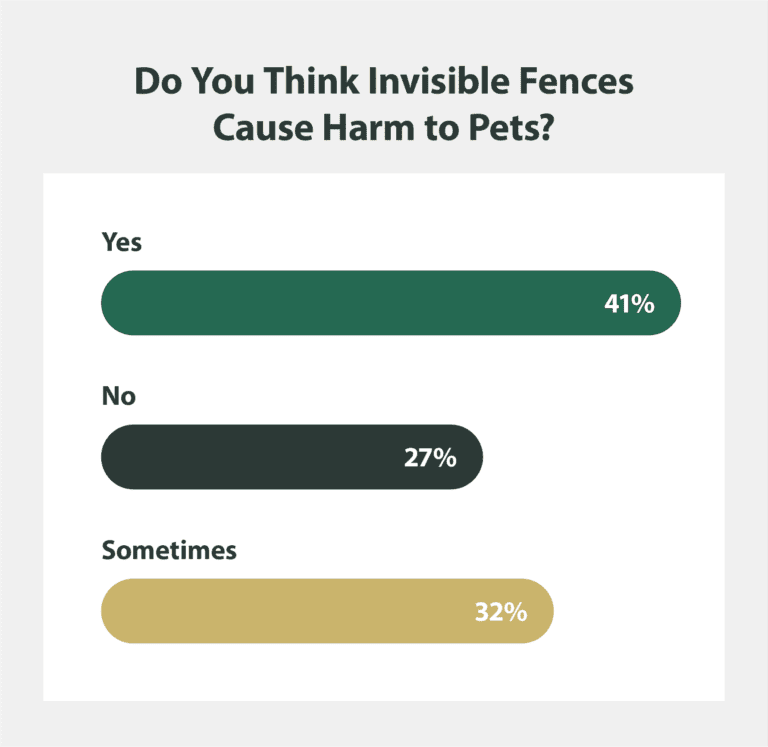Invisible fences have become more commonplace throughout the United States, so you may be more likely to encounter them if you visit or move into a new neighborhood. These fences utilize an underground wire that transmits an electrical pulse to a pet’s collar when they approach the boundary.
We’ve surveyed 1,055 people to see if they feel invisible fences are cruel and whether these devices are a net positive or net negative for pets. Our goal was to gauge the general sentiment around this pet containment system and determine whether people feel better using traditional fencing solutions or invisible fences to protect their pets.
Key Takeaways:
- 73% believe invisible fences can cause harm to pets.
- 54% prefer traditional fences over invisible fences.
- 45% of males would think poorly of someone who uses an invisible fence.
- 39% of women felt invisible fences shouldn’t be banned.
- 17% feel invisible fences should never be used.
- 15% feel invisible fences can cause anxiety in pets.
- Injury and physical distress were the biggest concerns for respondents.
- Electric fences are a form of positive punishment, according to the APDT.
In addition to learning what average people think about invisible fences, we also turned to veterinarians and trainers to see what experts have to say about them.
We’ll discuss our findings in detail to help you discover if an invisible fence would work for you on a practical and personal level.
How Exactly Do People Feel About Invisible Fences?
The primary concern about invisible fences is the ethics around using them. Although people have their reasons for using invisible fences, like keeping their dog within the boundaries of their yard, these fences send a shock to the animal through an electric collar. While animals may need training, are these fences ethical?
When we asked our respondents how they felt about invisible fences, we found that most of them felt that these are harmful to pets in one way or another. 41% stated outright that they believe these fences are harmful, while 32% felt these devices can be dangerous on occasion. The remaining 27% believed invisible fences weren’t harmful at all.
The potential for psychological and emotional harm leads many to wonder if invisible fences are fundamentally inhumane.

Do Professional Dog Trainers Find Invisible Fences Helpful?
It’s helpful to know the general sentiment about invisible fences, but it’s also beneficial to know what the experts think.
The argument for using invisible fences is that it’s a training device and deterrent for animals. We reached out to professional dog trainers to get their thoughts on whether or not the fences are accomplishing this goal.
Rhiannon van Lidth de Jeude Roemer, a professional positive reinforcement dog trainer from Raintown Dog Training, told us that invisible fences might make dogs more aggressive. “Aversive dog training tools, such as electric shock, have been shown to increase the risk of reactivity (aggression) in dogs.”
She then explained that a naturally friendly dog may learn the wrong associations. What may have been a fun experience can become scary. “If each time your dog runs out to greet a visitor or passerby they receive an electric shock, they are likely to create a negative association with people approaching or passing your home,” says Rhiannon.
What’s interesting is that we spoke with multiple dog trainers, and each one said that invisible fences can actually increase aggression in dogs.
However, only 3% of our survey respondents said they thought the primary harm was increased aggression.

How Effective Are Invisible Fences?
Not only did our respondents say that they think these fences are harmful, but they also doubted their effectiveness at keeping dogs within the confines of the yard. Only 23% percent of our respondents said they think these fences stop pets from running away.
Interestingly, our youngest respondents (ages 18-29) and our most senior participants (60+) both expressed a strong preference for traditional fences. 65% of our 18-29 respondents said they would install an invisible fence — which isn’t too far from the 58% of 60+ respondents who felt the same way.

Professional trainers are experts when it comes to what works when adjusting dogs’ behaviors, so we spoke with Bricks Coggin, the CEO of ABCs Puppy Zs. He told us that while these fences may work for some dogs, they aren’t foolproof.
“Many dogs, particularly those with high prey drives or strong motivations, may still cross the boundary despite the shocks,” Coggin says. He also went on to say that traditional fencing is still the best option. “Traditional fences, while potentially more costly, provide a more reliable and consistent barrier without the associated stress or risk of injury from electric shocks.”
The Social Risk of Using Invisible Fences
While many people find invisible fences perfectly ethical, it may be helpful to consider the social risk of using them.
As we learned, the majority of our respondents said they think invisible fences are harmful to pets, and they also don’t think they’re very effective. Although they may not use invisible fences for their own pets, we wanted to see how they felt about others using invisible fences for their pets.
The reported genders of our respondents suggest two distinct attitudes towards invisible fences and people who use them. While not the majority opinion, 45% of our male respondents said they would think negatively of a person who used an invisible fence.
In contrast, 39% of the female respondents said they would think poorly of neighbors who use these devices. Although there are some people who may think poorly of those using these fences, it’s not the majority for either gender.

How Much Harm Can Invisible Fences Cause?
The professional trainers we spoke to discussed the pitfalls of invisible fences when it comes to dogs’ behaviors, but we wanted to see what veterinarians had to say as well. No pet owner wants to intentionally harm their animal, but many don’t realize how invisible fences may affect their pet.
Dr. Alex Crow, a U.K. veterinary surgeon who works with the team at Pet Health Guru, has researched the topic thoroughly. “Studies have shown that dogs subjected to electric shock collars can develop anxiety, fear-based aggression, and even PTSD-like symptoms,” Dr. Alex told us. “In fact, 28% of dogs using shock collars exhibited increased anxiety and stress.”
As a veterinary surgeon, Dr. Alex has first-hand experience working with pets who have experienced physical harm from invisible fences. He says that we shouldn’t ignore the physical toll of these devices.
“I’ve treated dogs with burns, lesions, and even cardiac issues linked to invisible fence collars,” he told us before going on to say, “As a vet, it’s my duty to warn owners of the potential risks and encourage safer alternatives. No dog deserves to suffer in silence, and no owner should be left in the dark about the harm these collars can cause.”
Should You Use an Invisible Fence?
The opinions we’ve gathered from 1,055 respondents indicate an inclination towards traditional fences in the long run. While you might not think it’s cruel to use an invisible fence to restrain your pets, it’s not the safest option available.
Here are some of the advantages and disadvantages that come with using electric fencing:
Pros of Invisible Fences:
- They provide unobstructed views of nearby terrain.
- Using invisible fences in small areas can be cheaper.
- Invisible fences can be set up in any shape or pattern.
Cons of Invisible Fences:
- No physical barriers from outside threats.
- Repairs can be complicated.
- Pets may become distressed or even injured.
Overall, our respondents’ opinions suggest that you should only use an invisible fence under very specific circumstances. In most cases, wooden, metal, vinyl, or chain link fences offer a greater combination of protection and privacy for pets and pet owners.
Invisible Fence Alternatives
The answers provided by our respondents indicate that people largely feel uncertain about invisible fences; many seem to doubt that they’re safer, more effective, and more pet-friendly than conventional fences. We also have a great article on the best fences for dogs, if you’re looking for an alternative to invisible fences.
Top Rail Fence has years of experience installing high-quality fencing and railing solutions for various kinds of properties.
Check out our residential fence services to find safe and reliable options for pet containment and protection.
Methodology
The survey of over 1,000 adults aged 18+ was conducted via SurveyMonkey Audience for Top Rail Fence on 4/25/2024. Data is unweighted, and the margin of error is approximately +/-3% for the overall sample with a 95% confidence level.
64% of our respondents reported that they were females while 36% were males. 16% of respondents were aged 18-29, 30% were between 30 to 44, 38% were between 35 to 60, and 17% were 60+ years old.


